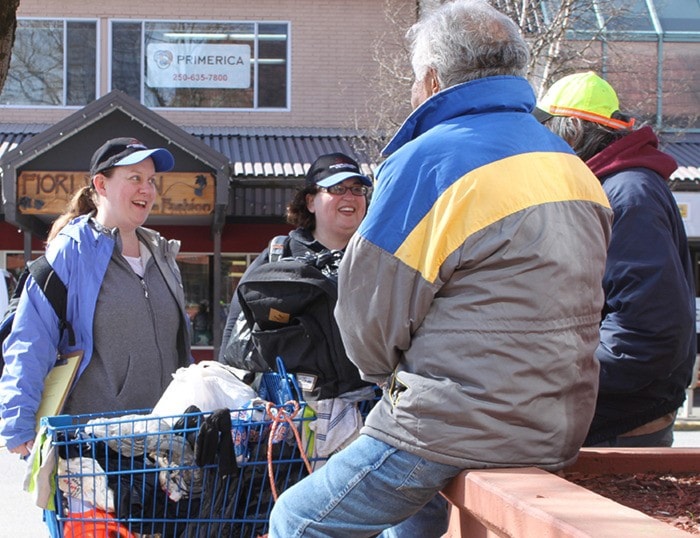A FIRST-EVER count of the homeless that took place here last week revealed at least 50 people have no place to live save for under porches, dumpsters, bank entrances and the outdoors.
Terrace and District Community Services Society (TDCSS) worker Casey Eys, who organized the count, said the number was dramatically higher than unofficial tallies he’s been keeping over the past several years.
“When I first started, you could count 15 to 18,” said Eys. “Before there were less transients.”
Eys, another person from TDCSS, and four Northwest Community College social work students, spent part of two days finding and interviewing people, even offering a free pair of socks on one of the rainy days as incentive for people to answer a questionnaire.
The count was part of ongoing efforts to determine the city’s housing policy priorities. It cost the city $2,500.
The group combed Ksan Society shelters, the weekday soup kitchen at the All Nations Centre on Sparks and ravines and thickets that wind through the area.
When asked where they had spent the night before, some of those surveyed listed flophouses which charge a fee and apartments where five sleep on the floor in addition to regular shelters.
Because a significant number of people live in precarious, unpredictable situations such as couch surfing or extended stays at relatives, defining who is homeless for the purpose of the survey was important and counting them an imperfect science.
“Anyone who doesn’t have control over their tenure is homeless because they have no legal security to be there,” said Eys.
A breakdown according to age, gender and ethnicity was not immediately available following the two-day count, which took place April 22-23.
The questionnaire contained a section that differentiates between those who had a place to stay the night before and those who were shelterless.
The survey is then done on those who answered that they are shelterless which means they slept outside, in a car or at someone else’s house.
According to city official Tara Irwin, the decision was made to restrict the counting to people without regular shelter.
“We also recognize the importance of enumerating the hidden homeless and those at risk of homelessness,” she said. “Given the scope of this project and the available resources, it was decided that focusing on the unsheltered homeless and those in emergency shelters be the focus.”
The survey also contained a section for people perceived to be homeless but who could not be interviewed.
According to Eys, housing is a far greater concern than food because while there are regular soup kitchens, shelters regularly suffer from overcapacity.
Some of those interviewed had differing circumstances leading them to become homeless.
One person, said volunteer Suzi Annala-Macdonald, said he was paying $600 a month for rent but was only receiving $610 a month in income assistance.
“I’ve heard a lot of bad reviews of the homeless shelters so some people would rather sleep in a dumpster or outside,” said another volunteer, Tracy Spencer, who was at the soup kitchen April 22 doing surveys.
While this was Terrace’s first homeless count, similar counts already take place in cities across B.C.
